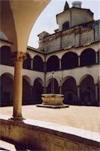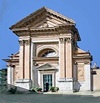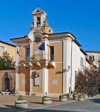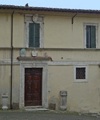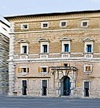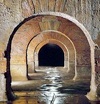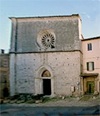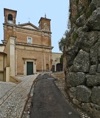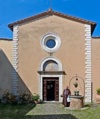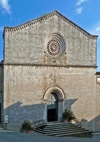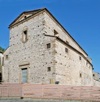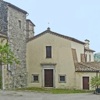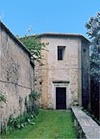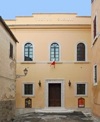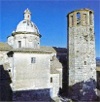City Walls and Gates of Amelia
This page describes the ancient and medieval walls of Amelia, together with five city gates:
-
✴Porta Romana (1592-1639);
-
✴Porta del Sole (probably Roman, rediscovered in 1944);
-
✴Porta Leone (ca. 847);
-
✴Porta Posterla (13th century); and
-
✴Porta della Valle (13th century).
Collegio Boccarini (13th century)
This palace, which was adapted to form part of the convent of San Francesco (see below), now houses the Museo Archeologico and the Pinacoteca.
Duomo (1640-80)
The Duomo was rebuilt on its original site, at the highest point in the city, after a fire in 1629. Its facade, which was destroyed in the earthquake of 1832, was rebuilt
in 1887.
Palazzo Comunale (early 19th century)
This municipal palace was built after its predecessor collapsed in 1817. Its courtyard houses a collection of archeological fragments.
Palazzo Vescovile (1685)
This palace stands on the site of the ancient baptistery, which was destroyed in 1240 by the Emperor Frederick II. There are three interesting Roman inscriptions against its facade.
Palazzo Farrattini (ca. 1517)
This important palace, which was designed by Antonio da Sangallo il Giovane, stands on the site of the Roman baths of Ameria.
Palaces of the Geraldini Family
-
✴Palazzo Geraldini del Borgo (originally 15th century);
-
✴Palace of Pace Busitani (originally 15th century?), the father of Alessandro Geraldini; and
-
✴Palazzo Battista Geraldini (1470s), the portal of which is illustrated here.
Palazzo Petrignani (1556-1605)
This palace contains a number of frescoes (16th century), some of which are attributed to Livio Agresti and Litardo Piccioli.
Other Patrician Palaces in Amelia
This page describes the following palaces:
-
✴Palazzo Boccarini (14th-17th centuries);
-
✴Palazzo Cansacchi (15th century), illustrated here;
-
✴Palazzo Nacci (14th-16th centuries); and
-
✴Palazzo Venturelli (16th century).
Roman Cisterns (2nd century AD)
The Romans built these ten huge caverns under the forum (Piazza Matteotti) to collect rainwater. They are open to the public.
Sant’ Agostino (14th century)
The Augustinians acquired an ancient chapel here in the 13th century. The current church is dated on stylistic grounds.
Sant' Angelo (16th century)
The church and monastery here belonged originally to the Jesuits. In 1601, the complex passed to the Somaschi Fathers, who established a seminary on the site. They left Amelia after the Napoleonic occupation. The complex has been recently restored and now houses the Scuola di Musica di Amelia.
SS Annunziata (14th century)
The church and Franciscan convent of SS Annunziata were first documented in 1373, when they belonged to the Clareni. The important altarpiece (ca. 1475) of the Annunciation was painted by Pier Matteo d’ Amelia for the high altar. The complex passed to the Observant Franciscans in 1567. The complex was suppressed in 1810 and again in 1866, but the Franciscans managed to return in 1882.
San Francesco (1287)
The Franciscans built this church on the site of an earlier parish church dedicated to SS Filippo e Giacomo. The façade (1401-6) contains a fine Gothic portal and rose window. The church contains the funerary monuments of a number of members of the Geraldini family.
San Magno (12th century)
The church of San Magno was ceded to the Abbazia di San Paolo fuori le Mura, Rome in 1179. A community of Benedictine nuns was established here, under the auspices of San Paolo fuori le Mura, in the 13th century. The convent was largely rebuilt in the 15th century and the church was remodelled in 1624. The complex, which has recently been restored, is now the home of six nuns.
Santa Maria delle Cinque Fonti (15th century)
This tiny church, which takes its name from a nearby medieval fountain, stands the site of an earlier chapel in which St Francis is believed to have preached in 1213. It contains interesting votive frescoes.
Santa Maria dei Laici (14th century)
This church and the adjoining hospice belonged to a confraternity, subsequently known as the Confraternita della Misericordia, that was first documented in 1306. A venerated Marian image was documented here in 1355. The original church seems to have been incorporated into the hospice by 1517, when the image was seen to sweat. The miracle prompted donations that financed the present church. It was re-dedicated as San Giovanni Decollato in 1570, when the Confraternita della Misericordia was incorporated into the Arciconfraternita di San Giovanni Decollato (or dei Fiorentini), Rome. The hospice/hospital closed in 1772 and the complex houses the Centro Culturale Santa Firmina.
Santa Monica (17th century)
[I cannot find anything on the history of this Augustinian nunnery]
San Secondo (12th century)
This Benedictine abbey was established on the site of an early Christian cemetery that is traditionally associated with the site of the burial of St Secundus The peace treaty of 1208 between Amelia and Todi was signed here. In the 16th century, the church became the home of the Confraternita della Buona Morte.
Other Churches in Amelia
T
his page describes the following churches:
-
✴Santa Caterina (1745-9);
-
✴San Girolamo (17th century), illustrated here;
-
✴Santa Lucia (1956);
-
✴Santa Maria di Porta (17th century); and
-
✴Santo Stefano (13th century).
Teatro Sociale (1783)
Stefano Cansacchi designed the theatre of Amelia, and it was redecorated by Domenico Bruschi in 1880-6. It is still in use, following its recent restoration.
Torre Civica (1050)
This lovely twelve-sided bell tower next to the Duomo is one of the few structures to have survived in Amelia from the Middle Ages.
Return to the home page on Amelia.



